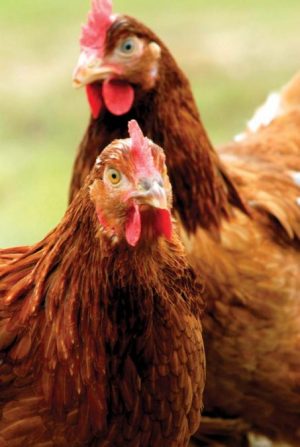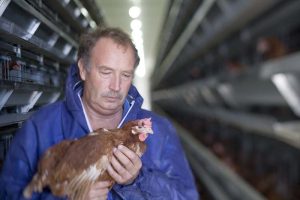Nutrient requirements of egg laying chickens
Nutrient Requirements of Egg Laying Chickens
The intake of nutrients is defined by the nutrient levels in the feed and the amount of feed consumed. Nutrient requirements of egg laying chickens is outlined below.
Feed consumption
There are a number of factors that influence voluntary feed intake (discussed in the section on feed intake). Table 1 provides data on typical feed consumption for modern brown-egg laying hens in relation to target body weight. From Week 18, hens start to enter their laying period, reaching peak of lay around 32 weeks of age, and typically maintaining egg production until 65-68 weeks of age. Feed intake will increase to a steady level of 100-105 grams per day and hen body weight will reach a mature level of 1700-1800 grams.

Table 1. Body weights and associated feed consumption for a brown-egg laying breed during the growing period
| Age (wk) | Body weight (g) | Feed consumption (g/bird/day) | Age (wk) | Body weight (g) | Feed consumption (g/bird/day) |
| 1 | 70 | 13 | 10 | 870-970 | 56 |
| 2 | 115 | 20 | 11 | 960-1080 | 61 |
| 3 | 190 | 25 | 12 | 1050-1117 | 66 |
| 4 | 280 | 29 | 13 | 1130-1250 | 70 |
| 5 | 380-390 | 33 | 14 | 1210-1310 | 73 |
| 6 | 480-500 | 37 | 15 | 1290-1370 | 75 |
| 7 | 580-620 | 41 | 16 | 1360-1430 | 77 |
| 8 | 680-750 | 46 | 17 | 1500-1540 | 80 |
| 9 | 770-860 | 51 |
For a complete, up-to-date guide, visit Hy-Line Management Guide Online.
Growing period nutrition recommendations
Chicks require a diet that can provide the nutrients needed for rapid growth and feather development. Chicks are given relatively high levels of energy, protein and the vitamins and minerals for the starter period. Once the chicks are fully feathered their energy requirements are reduced. Feeding management for layer pullets aims to maintain a growth rate that will lead to the pullet reaching sexual maturity at the desired age while avoiding obesity. The stage at which a pullet will start laying eggs is affected by age, body weight and day length. On a percentage basis, layer pullet diets have lower energy and protein levels than chick diets. Different breeders recommend different feeding strategies for their birds, including the number of different diets fed during the pullet growing stage. Many breeders recommend a pre-lay diet that increases some of the nutrient levels, such as calcium, that will be required by the bird when it begins to lay eggs. Table 2 provides data on typical nutrient levels for layer diets for the growing period.

Table 2. Growing period nutrition recommendations
| Nutrient | Units | Starter 0 – 6 wks |
Grower 6 – 12 wks |
Developer 12 – 15 wks |
Pre-Layer 15 wks – Prod. |
|
| Protein | % | Min | 20.0 | 17.50 | 15.50 | 16.50 |
| Metabolisable Energy | Mj/Kg | 11.5-12.4 | 11.5-12.6 | 11.3-12.4 | 11.4-12.4 | |
| Metabolisable Energy | Kcal/Kg | 2750-2970 | 2750-3025 | 2700-2970 | 2725-2980 | |
| Kcal/Lb | 1250-1350 | 1250-1370 | 1225-1350 | 1235-1350 | ||
| Lysine | % | Min | 1.10 | 0.90 | 0.66 | 0.80 |
| Methionine | % | Min | 0.48 | 0.41 | 0.32 | 0.38 |
| Methionine + Cystine | % | Min | 0.82 | 0.71 | 0.58 | 0.65 |
| Tryptophan | % | Min | 0.20 | 0.19 | 0.18 | 0.19 |
| Threonine | % | Min | 0.73 | 0.55 | 0.52 | 0.55 |
| Calcium | % | Min | 1.00 | 1.00 | 1.00 | 2.75* |
| Av Phosphorus | % | Min | 0.45 | 0.43 | 0.42 | 0.40 |
| Sodium | % | Min | 0.18 | 0.18 | 0.18 | 0.18 |
| Chloride | % | Min | 0.18 | 0.18 | 0.18 | 0.18 |
*At least 30-65% of the added limestone should have a minimum particle size of 2250 Microns.
For a complete, up-to-date guide, visit Hy-Line Management Guide Online.
Nutrient levels for layer diets
The aim of layer diets is to optimise egg production (in terms of egg numbers, egg size or egg mass), provide the nutrition required to safeguard health and maintain the desired body weight. As with layer pullets, different breeders recommend different feeding strategies for their birds, including the number of different diets fed during the laying stage. Calcium is increased for egg shell formation. Table 3 provides data on typical nutrient levels for layer diets.

Table 3. Examples of layer diets (at 100 grams per day intake level)
| Nutrients | Units | 1-32 wks | 32-44 wks | 44-55 wks | > 55 wks |
| Metabolisable Energy | MJ/kg | 11.60-11.97 | 11.41-11.97 | 11.20-11.97 | 10.68-11.83 |
| kcal/kg | 2770-2860 | 2725-2860 | 2675-2860 | 2550-2825 | |
| Crude protein | % | 19.80 | 17.50 | 17.00 | 16.00 |
| Lysine | % | 1.02 | 0.93 | 0.89 | 0.83 |
| Methionine | % | 0.51 | 0.46 | 0.41 | 0.38 |
| Linoleic acid | % | 1.10 | 1.60 | 1.60 | 1.60 |
| Calcium | % | 4.40 | 4.25 | 4.50 | 4.75 |
| Av.phosphorous | % | 0.48 | 0.40 | 0.36 | 0.35 |

